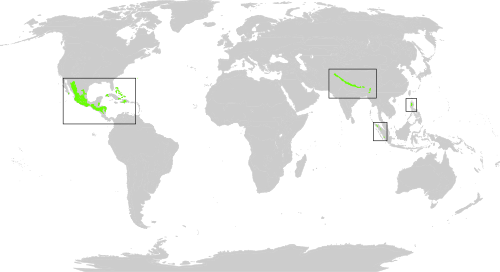Tropical and subtropical coniferous forests

Tropical and subtropical coniferous forests are a tropical forest habitat type defined by the World Wide Fund for Nature. These forests are found predominantly in North and Central America and experience low levels of precipitation and moderate variability in temperature. Tropical and subtropical coniferous forests are characterized by diverse species of conifers, whose needles are adapted to deal with the variable climatic conditions.[1] Most tropical and subtropical coniferous forest ecoregions are found in the Nearctic and Neotropical realms, from Mexico to Nicaragua and on the Greater Antilles, Bahamas, and Bermuda. Other tropical and subtropical coniferous forests ecoregions occur in Asia. Mexico harbors the world's richest and most complex subtropical coniferous forests.[2] The conifer forests of the Greater Antilles contain many endemics and relictual taxa.[1][3]
Many migratory birds and butterflies spend winter in tropical and subtropical conifer forests. This biome features a thick, closed canopy which blocks light to the floor and allows little underbrush. As a result, the ground is often covered with fungi and ferns. Shrubs and small trees compose a diverse understory.[1]
Tropical and subtropical coniferous forests ecoregions
[edit]| Himalayan subtropical pine forests | Bhutan, India, Nepal, Pakistan |
| Luzon tropical pine forests | Philippines |
| Northeast India–Myanmar pine forests | Myanmar, India |
| Sumatran tropical pine forests | Indonesia |
| Bermuda subtropical conifer forests | Bermuda |
See also
[edit]References
[edit]- ^ a b c
 This article incorporates text available under the CC BY-SA 3.0 license. World Wide Fund for Nature. "Tropical and Suptropical Coniferous Forest Ecoregions". Archived from the original on 2010-05-12.
This article incorporates text available under the CC BY-SA 3.0 license. World Wide Fund for Nature. "Tropical and Suptropical Coniferous Forest Ecoregions". Archived from the original on 2010-05-12.
- ^ Perry, JP Jr. (1991). The pines of Mexico and Central America. Portland, Oregon, USA: Timber Press.
- ^ Borhidi, A (1991). Phytogeography and vegetation ecology of Cuba. Budapest, Hungary: Akadémiai Kiadó.
- ^ Gong, Yuan; Staudhammer, Christina L.; Wiesner, Susanne; Starr, Gregory; Zhang, Yinlong (2021-01-16). "Characterizing Growing Season Length of Subtropical Coniferous Forests with a Phenological Model". Forests. 12 (1): 95. Bibcode:2021Fore...12...95G. doi:10.3390/f12010095. ISSN 1999-4907.
- ^ Eberhardt, Thomas L; So, Chi-Leung; Leduc, Daniel L (2018-07-20). "Wood Variability in Mature Longleaf Pine: Differences Related to Cardinal Direction for a Softwood in a Humid Subtropical Climate". Wood and Fiber Science. 50 (3): 323–336. doi:10.22382/wfs-2018-031. ISSN 0735-6161.
- ^ Ojha, Santosh K.; Dimov, Luben D.; Tadesse, Wubishet (2021-01-19). "Growth, proportion, and distribution pattern of longleaf pine across southeastern forests and disturbance types: A change assessment for the period 1997-2018". PLOS ONE. 16 (1) e0245218. Bibcode:2021PLoSO..1645218O. doi:10.1371/journal.pone.0245218. ISSN 1932-6203. PMC 7815114. PMID 33465105.
- ^ Bigelow, Seth W.; Rollosson, Anna; Vogel, Jason; Whelan, Andrew W.; Rother, Monica (2023). "Hardwoods influence effect of climate and intraspecific competition on growth of woodland longleaf pine trees". Ecosphere. 14 (4) e4482. Bibcode:2023Ecosp..14E4482B. doi:10.1002/ecs2.4482. ISSN 2150-8925.
- ^ Jose, Shibu; Jokela, Eric J.; Miller, Deborah L. (2006), Jose, Shibu; Jokela, Eric J.; Miller, Deborah L. (eds.), "The Longleaf Pine Ecosystem", The Longleaf Pine Ecosystem: Ecology, Silviculture, and Restoration, New York, NY: Springer, pp. 3–8, doi:10.1007/978-0-387-30687-2_1, ISBN 978-0-387-30687-2
- ^ "NatureServe Explorer 2.0". explorer.natureserve.org. Retrieved 2025-09-22.
External links
[edit] Media related to Tropical and subtropical coniferous forests at Wikimedia Commons
Media related to Tropical and subtropical coniferous forests at Wikimedia Commons
